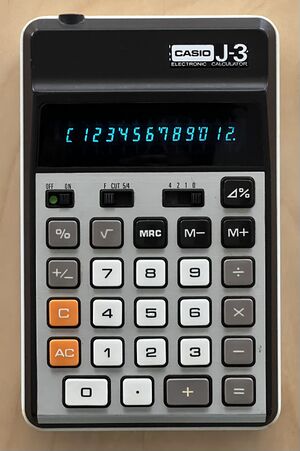Casio J-3: Difference between revisions
(Added gallery) |
mNo edit summary |
||
| (One intermediate revision by one other user not shown) | |||
| Line 1: | Line 1: | ||
{{Infobox calculator|name=Casio J-3|image=Image:Casio J-3.jpg|manufacturer=Casio Computer Co.|dimensions=158(w) x 98(l) x 22(h) mm|prog_lang=N/A|precision=12+0|connection=5.5x2.5mm barrel connector|power=25mW up to 100mW|supply=3.2V 100mA DC power supply or 2x AA|weight=180g|processor=Hitachi HD38401|entry=Algebraic|display_type=VFD}} | |||
{{Infobox calculator|name=Casio J-3|image=Image:Casio J-3.jpg|manufacturer=Casio Computer Co.|dimensions=158(w) x 98(l) x 22(h) mm|prog_lang=N/A|precision=12+0|connection=5.5x2.5mm barrel connector|power=25mW up to 100mW|supply=3.2V 100mA}} | |||
The '''Casio J-3''' is a basic 6 function calculator produced by [[Casio]] in Japan. The main features of this calculator are its memory functionality and large display. | The '''Casio J-3''' is a basic 6 function calculator produced by [[Casio]] in Japan. The main features of this calculator are its memory functionality and large display. | ||
| Line 23: | Line 19: | ||
* [[Casio MEMORY-8]] | * [[Casio MEMORY-8]] | ||
[[Category:Casio]] | |||
[[Category:Vintage calculator]] | |||
[[Category:Pocket calculator]] | |||
[[Category:VFD]] | |||
Latest revision as of 19:12, 12 July 2022
The Casio J-3 is a basic 6 function calculator produced by Casio in Japan. The main features of this calculator are its memory functionality and large display.
Internal design[edit | edit source]
This calculator is based upon the Hitachi HD38401 calculator ASIC, which incorporates the key matrix polling, arithmetic, and display control all into a single chip. The Casio J-3 uses an unusually large vacuum fluorescent display module, the Toshiba E6610, with thirteen 9 segment digits.
The key mechanism used consists of sheets of conductive plastic that are pressed against a metal pad by the keys, normally held apart by a non-conductive sheet of plastic. As the calculator has aged, the actuation force required for a key press has increased significantly. The keypad PCB is connected to the main board by uninsulated copper pins, over time these can become damaged from repeatedly opening the calculator or can be corroded away by battery leakage.




